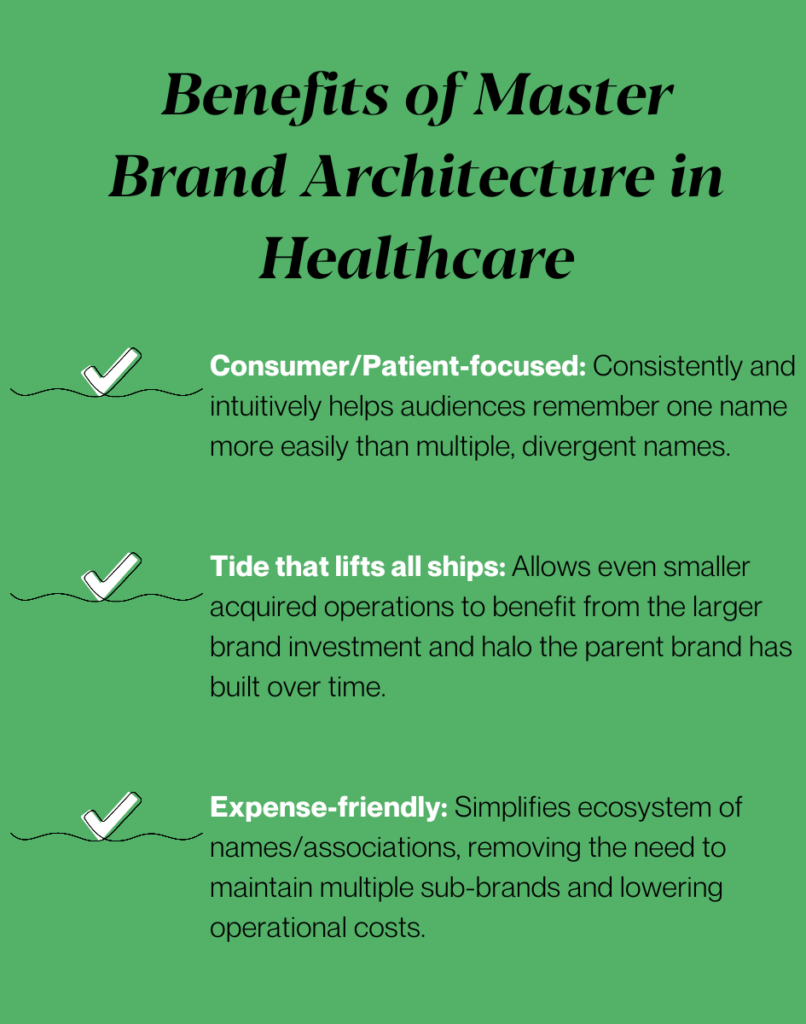The healthcare industry is changing fast. Hospitals and healthcare systems are consolidating through mergers and acquisitions, looking to bolster their leverage with insurance companies while cutting costs. And many are branching into new areas to boost their bottom line.
But in the excitement of these changes, rebranding is often overlooked. When an acquisition occurs, there can often be a question of branding and signage—and considering that too late can make assimilation tricky at best and costly at most.
For those who employ a master brand approach, tap into your master brand architecture while keeping some of these best practices top of mind.
Timing is everything.
Raise and address any brand issues before the final acquisition contracts are signed. Setting clear expectations around the scope and timing of the rebranding process will help prevent future complications, as will outlining what’s needed in the interim period. Will you allow an interim period with provisional branding? What will cause the least consumer confusion? What will the new DBA (“doing business as”) brand names be?
Another critical consideration: When will the acquired entity’s operations be aligned with the parent organization? Your brand is far more than your logo and signage; it’s the entire patient experience, which is driven by organizational culture, values, training, quality and safety protocols. Ideally, the timing of the brand transition and the operational transitions align. Otherwise, marketing may raise consumer expectations further and faster than operations can deliver—potentially doing more harm than good.

Strong master brands thrive in today’s competitive healthcare environment.
If you’re the acquiring entity, know that your master brand is worth defending.
A master brand architecture system organizes the institution’s service lines into a naming convention that directly leverages the parent company; think Mayo Clinic, or HCA Healthcare. The beauty of a master brand strategy is its simplicity and consistency. By implementing a clearly defined brand platform, organizations ensure that consumers need to remember only one overarching name. That enables marketing investments to have a broader impact. When all services and divisions are unified under a single brand, marketing efforts for one area can effectively boost recognition and perception of the entire organization.
Review—and revise—your brand guidelines.
Ensure that your organization’s brand guidelines document is current and comprehensive. If you’re anticipating a significant interim phase, consider adding a section dedicated to interim branding guidelines. For acquired entities with strong brand equity or unique service offerings, including standards for an extended interim period may be prudent. Approaching the acquisition and brand integration as a multi-step process, and making provisions for those in-between stages, will help preserve valuable brand assets throughout the transition.
Timing is crucial when planning launch advertising in new geographic markets. If your launch isn’t immediate, there’s an argument to be made for extending the interim branding to avoid consumer confusion. But, regardless of the timeline, focus on building a cohesive brand system. Maintaining consistency across all touchpoints—from logo and naming structure to color palette and fonts—reinforces brand identity and enhances patient experience.
Govern your branding.
One of the most significant pitfalls in healthcare post M&A brand integration is failing to ensure that acquired entities fully adopt the parent company’s brand guidelines. It’s not uncommon for acquired medical groups to resist or even refuse to align with the parent company’s branding, so you may need to establish a timeline (and rationale) for them to migrate into your brand architecture. According to a report by McKinsey and Company, most acquiring companies (65%) complete brand migration within 12 months of acquisition (35% within 18 months).
As the healthcare industry continues its rapid evolution, those who prioritize strategic and effective brand management will be better positioned to thrive. By addressing branding issues early, leveraging a strong master brand architecture, maintaining comprehensive brand guidelines and ensuring proper governance of brand integration, healthcare organizations can set themselves up for success, no matter the scope.
